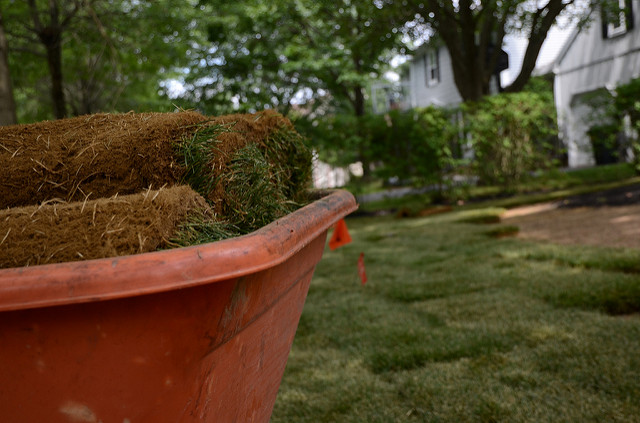Sod is a lot of work to install, but it can be a lot quicker than waiting for seeds to grow and gives you thicker coverage. When do you use it, though? How do you care for freshly-laid sod? Knowing these facts can mean the difference between a weak lawn and a strong one.
Follow this quick guide if you’re considering sod for your new lawn. A lot of tender love and care will mean a healthier, hearty, green lawn!
When to Use: New Property
Sod is necessary for when time is of the essence. If you can’t wait for seeds to grow into thick coverage, or you don’t have the time to tend to the ground where you’ve seeded, installing sod is the best option.
Lay sod during the spring or early autumn, when the temperatures are cool (but not too cool!), the rain is more consistent, and you won’t need to mow it, so you can give it some alone time to grow healthy. Anytime during the growing season, though, is good, so if you need it during the summer, go ahead!
When to Use: Repairing a Damaged Lawn
Sod is an extreme measure for repairs, but sometimes it’s necessary. In a drought, grass can go dormant and be revived with consistent watering, but sometimes, dead is dead. If you’ve got limited time, it can be a way of reviving your greenery.
You’ll have to remove the existing grass with a sod cutter or rototiller. If the grass is very thin and you want to install sod, clear it out with a lawn killer like glyphosate.
What to do with New Sod
If you’re looking to install new sod, it’s important to keep several things in mind:
- Prepare the ground. Get rid of the current grass (using the methods described in the “Repairing a Damaged Lawn” section), clear out the debris, and level the ground.
- If needed, put down a thin layer of a good quality top soil.
- Lay the sod within 6 to 12 hours after receiving your order, so keep your timeline in mind!
- After it has been laid, use a turf starter fertilizer and water as soon as you’ve laid it down!
- Rent a sod roller to even out the lawn and flatten out the edges.
If you’re not comfortable with the process – and it’s a big process you need to make time for! – give us a call! We’ll tend your new lawn and ensure it grows healthy and deep.
 Care Tips
Care Tips
The first weeks of care are incredibly important. You need to water the lawn regularly for extended periods of time to ensure it grows strong, deep roots. The water has to penetrate not just the sod, but at least two inches into the soil. If water runs out the bottom, you’ll know it’s saturated. If you’ve oversaturated the lawn, lay off the watering for a day.
Overwatering can be a problem, though. It can make roots shallow and weak, and make the grass system susceptible to fungus, insects, and diseases. You can check the roots by lifting the corner of one of the “squares” you’ve laid down. If it’s difficult to lift after a couple of weeks, the roots are getting into the soil; if you can still lift it, the roots are weak and you might be overwatering.
Try your best to stay off it for the first two weeks. Don’t use water for a day or two prior to your first mow.


Recent Comments